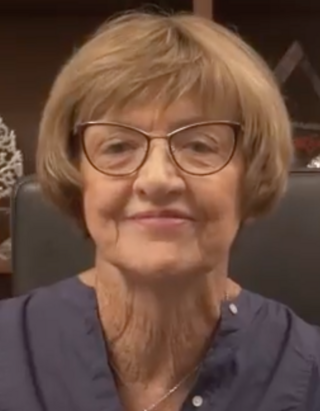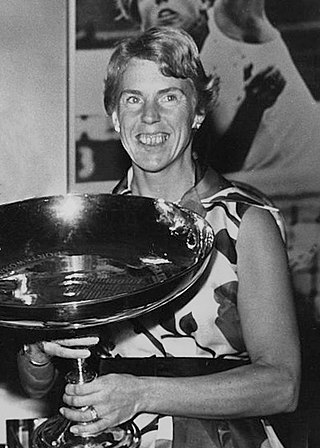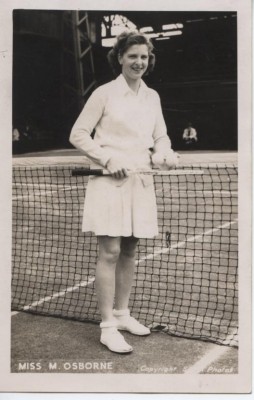
Margaret Court, also known as Margaret Smith Court, is an Australian former world number 1 tennis player and a Christian minister. Considered one of the greatest tennis players of all time, her 24 women's singles major titles and total of 64 major titles are the most in tennis history.

Maria Esther Andion Bueno was a Brazilian professional tennis player. During her 11-year career in the 1950s and 1960s, she won 19 major titles, making her the most successful South American tennis player in history, and the only one to ever win Wimbledon. Bueno was the year-end No. 1 female player in 1959 and 1960 and was known for her graceful style of play.

Ann Shirley Jones, is a British former table tennis and lawn tennis champion. She won eight Grand Slam tennis championships in her career: three in singles, three in women's doubles, and two in mixed doubles. As of 2023, she serves as a vice president of the All England Lawn Tennis and Croquet Club.

Francis Arthur Sedgman is an Australian former world No. 1 tennis player. Over the course of a three-decade career, Sedgman won five Grand Slam singles tournaments as an amateur as well as 22 Grand Slam doubles tournaments. He is one of only five tennis players all-time to win multiple career Grand Slams in two disciplines, alongside Margaret Court, Roy Emerson, Martina Navratilova and Serena Williams. In 1951, he and Ken McGregor won the Grand Slam in men's doubles. Sedgman turned professional in 1953, and won the Wembley World Professional Indoor singles title in 1953 and 1958. He also won the Sydney Masters tournament in 1958, and the Melbourne Professional singles title in 1959. He won the Grand Prix de Europe Professional Tour in 1959.

Alejandro "Alex" Olmedo Rodríguez was a tennis player from Peru with American citizenship. He was listed by the USTA as a "foreign" player for 1958, but as a U.S. player for 1959. He helped win the Davis Cup for the United States in 1958 and was the No. 2 ranked amateur in 1959. Olmedo won two Majors in 1959 and the U.S. Pro Championships in 1960, and was inducted into the Tennis Hall of Fame in 1987.

Sir Norman Everard Brookes was an Australian tennis player. During his career he won three Grand Slam singles titles; Wimbledon in 1907 and 1914 and the Australasian Championships in 1911. Brookes was part of the Australasian Davis Cup team that won the title on six occasions. The Australian Open men's singles trophy, the Norman Brookes Challenge Cup, is named in his honour. After his active playing career Brookes became president of the Lawn Tennis Association of Australia.

Ashley John Cooper AO was an Australian tennis player who played between 1953 and 1968. He was ranked as the world's No. 1 amateur player during the years of 1957 and 1958. Cooper won four singles and four doubles titles at Grand Slam tournaments. He won three of the four Grand Slam events in 1958. He turned professional in 1959. Cooper won the Slazenger Professional Championships tournament in 1959. He won the Grand Prix de Europe professional tour of Europe in 1960. Cooper won the European Cup professional tour of Europe in 1962. He retired from tennis play at the end of 1962 due to injury.

Margaret Osborne duPont was a world No. 1 American female tennis player.

Edward John Patty, better known as Budge Patty, was an American world no. 1 tennis player whose career spanned a period of 15 years after World War II. He won two Grand Slam singles titles in 1950. He was the second American male player to win the Channel Slam and one of only three as of 2024.

Nicola "Nicky" Pietrangeli is an Italian former tennis player. He won two singles titles at the French Championships and is considered by many to be one of Italy's greatest tennis champions.

Sven Viktor Davidson was a Swedish tennis player who became the first Swede to win a Grand Slam title when he won the French Championships in 1957, beating Ashley Cooper and Herbert Flam.
Florence Angela Margaret Mortimer Barrett, MBE is a British former world No. 1 tennis player. Mortimer won three Grand Slam singles titles: the 1955 French Championships, the 1958 Australian Championships, and 1961 Wimbledon Championships when she was 29 years old and partially deaf.

Gerald Leighton PattersonMC was an Australian tennis player.
Whitney Reed was a U.S. No. 1 tennis player from the United States who was active in the 1950s and 1960s.

Hamilton Farrar Richardson was an American tennis player, who was active in the 1950s and 1960s.

Eleanor "Nell" Mary Hall Hopman, CBE was one of the female tennis players that dominated Australian tennis from 1930 through the early 1960s. She was the first wife of Harry Hopman, the coach and captain of 22 Australian Davis Cup teams.

Robert 'Bob' Mark was an amateur tennis player from Australia.
Janet Hopps Adkisson is a former professional tennis player from the U.S. Adkisson was ranked in the top 15 female tennis players three times, and was, according to the State of Washington Sports Hall of Fame, "once recognized as one of the world's top woman tennis players".

Ladislav "Laci" Legenstein is a Croatian–born Austrian former tennis player. He was active from 1950 to 1975 and won 13 career singles titles.
John Hillebrand is an Australian former tennis player who was active from the late 1950s until the early 1970s. His best finish in a Grand Slam tournament came in 1963, when he reached the men's doubles quarterfinals of the Australian Open with partner Peter McPherson.
















